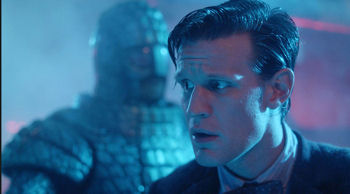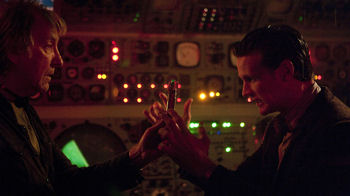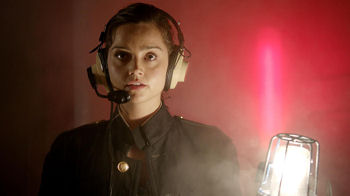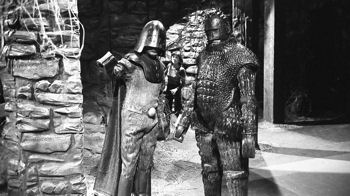Mark Gatiss has failed to make the Ice Warriors scary again.
That’s because they weren’t scary in the first place, so it wouldn’t be possible to make them scary “again.”
Well, okay, I wasn’t even alive in the 60s, let alone watching Doctor Who from behind the apocryphal sofa, so it’s possible that to a little kid they didn’t look like grinning portly turtles waddling around on two legs through the snow, or that their whispery hissing voices sounded sinister rather than constantly out of breath. And maybe if the first story I’d seen them in, 1972's “The Curse of Peladon,” hadn’t featured as a plot twist (watch out, 41-year-old spoiler ahead!) the Ice Warriors as honorable good guys, I might have been able to see them as frightening enemies to be reckoned with.
But you know, though I kid the big green galoots, truth is I actually always kind of liked them. And I actually kind of like this episode.
Now, it’s true that the main strategy Gatiss employs for making this Ice Warrior scary is to steal tricks from the Alien movies. The scene where it’s loose in a room with Clara; the bit where it dashes past the other characters after chestbursting; the bit where it hides in the walls and reaches down from the ceiling with long talons to grab people by the head; the bit where it picks people off one by one because they’re stupid enough to split up; we’ve seen all this before.
But Gatiss is also layering in The Hunt for Red October and 1951's The Thing from Another World, which makes this whole mélange work somehow. And frankly, Doctor Who did Alien first and called it “The Ark in Space,” so who’s zoomin’ who?
 The important point here is that Gatiss accomplishes this lurking horror plot by doing something that, no argument possible, has ever been done with the Ice Warriors: he takes off their armor. And apparently, underneath all those heavy ridges and big broad shoulders, they’re squishy little lizards with low-slung gaits, delicate wrists, and long pointy talons, like if Randall from Monsters, Inc. were sickly green and needed a manicure.
The important point here is that Gatiss accomplishes this lurking horror plot by doing something that, no argument possible, has ever been done with the Ice Warriors: he takes off their armor. And apparently, underneath all those heavy ridges and big broad shoulders, they’re squishy little lizards with low-slung gaits, delicate wrists, and long pointy talons, like if Randall from Monsters, Inc. were sickly green and needed a manicure.
I found this a little hard to credit at first, trying to picture how those long fingers could possibly fit inside the short stubby Ice Warrior gauntlets, but if you don’t give a little artistic license here, having the Ice Warrior slip out of its armor is a non-starter storywise. And it certainly makes the need for the armor more apparent.
The biggest problem with “Cold War” is that the entire episode exists first and foremost to Bring Back The Ice Warriors, and only secondarily to have anything remotely interesting to say about the historical Cold War or feature characters we can believe in or care about. Liam Cunningham does a dependable but uninspiring job in the role of Looking Vaguely Like Sean Connery Circa 1990, while his Game of Thrones colleague Tobias Menzies barely registers a single emotion as the supposedly hotheaded young hawk.
Everyone else in this crew looks and sounds like the most British Russians imaginable, which is probably okay given that almost nothing in the script makes it matter whether they’re from the East or the West. With one ghastly exception, everyone else is a cipher whose deaths are too anonymous to move us, including Piotr whose unmotivated enthusiasm with a blowtorch sets the whole plot moving.
 That ghastly exception is, of course, David Warner, thoroughly miscast as the supposedly charming and genial Professor Grisenko. We know he’s charming and genial because he enters the episode clutching a Walkman and tunelessly moaning the chorus of an Ultravox song (“Vienna”) whose lyrics (“This means nothing to me”) telegraph that he’s the one who’s above all this Cold War nonsense. He just cares about Science! which is why he has what is obviously a seven-foot humanoid in a block of ice but thinks he’s found a mammoth (we can assume he’s lying to the captain, but there’s no way to be sure).
That ghastly exception is, of course, David Warner, thoroughly miscast as the supposedly charming and genial Professor Grisenko. We know he’s charming and genial because he enters the episode clutching a Walkman and tunelessly moaning the chorus of an Ultravox song (“Vienna”) whose lyrics (“This means nothing to me”) telegraph that he’s the one who’s above all this Cold War nonsense. He just cares about Science! which is why he has what is obviously a seven-foot humanoid in a block of ice but thinks he’s found a mammoth (we can assume he’s lying to the captain, but there’s no way to be sure).
I don’t blame Gatiss here. On paper, this guy really could have been adorable and sweet, but either the director or the actor is unable to stop David Warner from being David Warner. He comes off as even creepier than the Ice Warrior most of the time, especially and most unfortunately when he’s trying to comfort Clara and/or convince her to join him in a rousing chorus of “Hungry Like the Wolf.” Someone else could maybe have pulled this off and turned this improbable goofy character into one of the darlings of the season. David Warner is a fine actor and he does his best here, but he’s just not what the doctor ordered.
Then there’s Jenna-Louise Coleman, revealing the limits of her range. She’s still terrific with a quip (the “Pinocchio” line, perfectly delivered) or a quizzical look (like the one she shoots the Doctor when he kisses his blonde Barbie doll (?!) that dresses like Rose), but she never really looks scared, and her key speech, about the dismembered corpses making everything seem “real” all of a sudden, falls flat.
 We might blame the director here, who seems decidedly focused on successfully making everything look evocatively cramped and yet gorgeous (I’ve never seen a more stylish depiction of waking up from a faint) at the expense of help the actors make dramatic sense of Gatiss’s skeletal script. “Cold War,” clocking in at 41:28 (including the trailer for the next episode), is only 7 seconds longer than “The Power of Three,” and like the latter it really could have used another three and a half minutes. With the extra time for character development, it might have been a little more dismaying to watch Grand Marshal Skaldak’s green talons caressing the heads of the Russians, but since we barely know them and don’t care about them, all we can focus on is how unconvincing the visual effect is.
We might blame the director here, who seems decidedly focused on successfully making everything look evocatively cramped and yet gorgeous (I’ve never seen a more stylish depiction of waking up from a faint) at the expense of help the actors make dramatic sense of Gatiss’s skeletal script. “Cold War,” clocking in at 41:28 (including the trailer for the next episode), is only 7 seconds longer than “The Power of Three,” and like the latter it really could have used another three and a half minutes. With the extra time for character development, it might have been a little more dismaying to watch Grand Marshal Skaldak’s green talons caressing the heads of the Russians, but since we barely know them and don’t care about them, all we can focus on is how unconvincing the visual effect is.
Matt Smith, of course, almost never needs a director’s help, and he’s terrific as usual turning on a dime from comedy to drama, sometimes in the course of a single sentence (“and oh look, you’ve got me telling you about them and I said there wasn’t time!“). Even by his own standards he’s great here, carrying the gravity of the piece when it’s time to get serious and not undercutting it the way he might have in the past.
It’s only at the end that he fails to be mesmerizing, stuck with one of those melodramatic standoff threats where he promises to blow up the nuclear sub rather than allowing Skaldak to launch nuclear missiles against humanity. No one really seems to believe he’ll do it, including him, but his ploy succeeds because that’s what the script says happens.
And that’s the other big problem here: we’re supposed to see Skaldak as a great military leader, a ruthless serial-killing monster, and as a merciful father, but his shifts in character are so mechanistic that the Doctor has to spell them out for us rather than allowing the voice acting or the character’s behavior to integrate them into a single individual with a believable emotional arc. Given that most of his predecessors have had the acting range of a constipated turtle, though, maybe we can still see this as a step forward.
 Classic series watch:
Classic series watch:
The Ice Warriors were introduced in 1967 in, er, “The Ice Warriors.” They tried to invade Earth in 1969's “The Seeds of Death,” and after the aforementioned “The Curse of Peladon,” pulled a double-bluff and went back to being jerks in 1974 for “The Monster of Peladon.”
This is the first time we’ve seen them again since that story, the first time we’ve seen them out of their armor, the first time we’ve seen one solo, and the first time we’ve seen one with fingers. Ice Warriors with fingers make a lot more sense than Silurians with breasts, though, so why not.

 The important point here is that Gatiss accomplishes this lurking horror plot by doing something that, no argument possible, has ever been done with the Ice Warriors: he takes off their armor. And apparently, underneath all those heavy ridges and big broad shoulders, they’re squishy little lizards with low-slung gaits, delicate wrists, and long pointy talons, like if Randall from Monsters, Inc. were sickly green and needed a manicure.
The important point here is that Gatiss accomplishes this lurking horror plot by doing something that, no argument possible, has ever been done with the Ice Warriors: he takes off their armor. And apparently, underneath all those heavy ridges and big broad shoulders, they’re squishy little lizards with low-slung gaits, delicate wrists, and long pointy talons, like if Randall from Monsters, Inc. were sickly green and needed a manicure.  That ghastly exception is, of course, David Warner, thoroughly miscast as the supposedly charming and genial Professor Grisenko. We know he’s charming and genial because he enters the episode clutching a Walkman and tunelessly moaning the chorus of an Ultravox song (“Vienna”) whose lyrics (“This means nothing to me”) telegraph that he’s the one who’s above all this Cold War nonsense. He just cares about Science! which is why he has what is obviously a seven-foot humanoid in a block of ice but thinks he’s found a mammoth (we can assume he’s lying to the captain, but there’s no way to be sure).
That ghastly exception is, of course, David Warner, thoroughly miscast as the supposedly charming and genial Professor Grisenko. We know he’s charming and genial because he enters the episode clutching a Walkman and tunelessly moaning the chorus of an Ultravox song (“Vienna”) whose lyrics (“This means nothing to me”) telegraph that he’s the one who’s above all this Cold War nonsense. He just cares about Science! which is why he has what is obviously a seven-foot humanoid in a block of ice but thinks he’s found a mammoth (we can assume he’s lying to the captain, but there’s no way to be sure).  We might blame the director here, who seems decidedly focused on successfully making everything look evocatively cramped and yet gorgeous (I’ve never seen a more stylish depiction of waking up from a faint) at the expense of help the actors make dramatic sense of Gatiss’s skeletal script. “Cold War,” clocking in at 41:28 (including the trailer for the next episode), is only 7 seconds longer than “
We might blame the director here, who seems decidedly focused on successfully making everything look evocatively cramped and yet gorgeous (I’ve never seen a more stylish depiction of waking up from a faint) at the expense of help the actors make dramatic sense of Gatiss’s skeletal script. “Cold War,” clocking in at 41:28 (including the trailer for the next episode), is only 7 seconds longer than “ Classic series watch:
Classic series watch:





